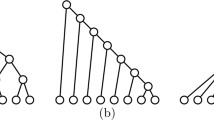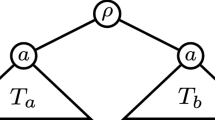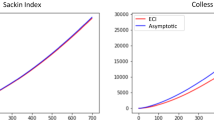Abstract
We define a new balance index for rooted phylogenetic trees based on the symmetry of the evolutive history of every set of 4 leaves. This index makes sense for multifurcating trees and it can be computed in time linear in the number of leaves. We determine its maximum and minimum values for arbitrary and bifurcating trees, and we provide exact formulas for its expected value and variance on bifurcating trees under Ford’s \(\alpha \)-model and Aldous’ \(\beta \)-model and on arbitrary trees under the \(\alpha \)–\(\gamma \)-model.












Similar content being viewed by others
References
Abramowitz M, Stegun IAS (1972) Handbook of mathematical functions with formulas, graphs, and mathematical tables. Dover, New York
Aldous D (1996) Probability distributions on cladograms. In: Aldous D, Pemantle R (eds) Random discrete structures. The IMA voumes in mathematics and its applications, vol 76. Springer, New York, pp 1–18
Aldous D (2001) Stochastic models and descriptive statistics for phylogenetic trees, from Yule to today. Stat Sci 16:23–34
Blum MGB, François OF (2005) On statistical tests of phylogenetic tree imbalance: the Sackin and other indices revisited. Math Bioscinces 195:141–153
Cardona G, Mir A, Rosselló F (2013) Exact formulas for the variance of several balance indices under the Yule model. J Math Biol 67:1833–1846
Cavalli-Sforza LL, Edwards A (1967) Phylogenetic analysis: models and estimation procedures. Evolution 21:550–570
Chen B, Ford D, Winkel M (2009) A new family of Markov branching trees: the alpha–gamma model. Electron J Probab 14:400–430
Colless DH (1982) Review of “phylogenetics: the theory and practice of phylogenetic systematics”. Syst Zool 31:100–104
Cormen TH, Leiserson CE, Rivest RL, Stein C (2009) Introduction to algorithms, 3rd edn. The MIT Press, Cambridge
Coronado TM, Mir A, Rosselló F (2018) The probabilities of trees and cladograms under Ford’s \(\alpha \)-model. Sci World J 2018:1916094
Dearlove BL, Frost SD (2015) Measuring asymmetry in time-stamped phylogenies. PLoS Comput Biol 11.7(2015):e1004312
Felsenstein J (2004) Inferring phylogenies. Sinauer Associates Inc., Sunderland
Ford D (2005) Probabilities on cladograms: introduction to the alpha model. arXiv preprint arXiv:math/0511246
Harding E (1971) The probabilities of rooted tree-shapes generated by random bifurcation. Adv Appl Probab 3:44–77
Keller-Schmidt S, Tuğrul M, Eguíluz VM, Hernández-García E, Klemm K (2015) Anomalous scaling in an age-dependent branching model. Phys Rev E 91:022803
Kirkpatrick M, Slatkin M (1993) Searching for evolutionary patterns in the shape of a phylogenetic tree. Evolution 47:1171–1181
Macdonald IG (1995) Symmetric functions and Hall polynomials, 2nd edn. Oxford University Press, Oxford
Matsen F (2007) Optimization over a class of tree shape statistics. IEEE/ACM Trans Comput Biol Bioinform (TCBB) 4:506–512
McKenzie A, Steel M (2000) Distributions of cherries for two models of trees. Math Biosci 164:81–92
Mir A, Rosselló F, Rotger L (2013) A new balance index for phylogenetic trees. Math Biosci 241:125–136
Mir A, Rotger L, Rosselló F (2018) Sound Colless-like balance indices for multifurcating trees. PLoS ONE 13(9):e0203401
Mooers A, Heard SB (1997) Inferring evolutionary process from phylogenetic tree shape. Q Rev Biol 72:31–54
Pinelis I (2003) Evolutionary models of phylogenetic trees. Proc R Soc Lond B Biol Sci 270:1425–1431
Rosen DE (1978) Vicariant patterns and historical explanation in biogeography. Syst Biol 27:159–188
Sackin MJ (1972) Good and “bad” phenograms. Syst Zool 21:225–226
Shao KT, Sokal R (1990) Tree balance. Syst Zool 39:226–276
Sloane NJA (2010) The on-line encyclopedia of integer sequences. http://oeis.org/. Accessed 30 Apr 2019
Wu T, Choi KP (2016) On joint subtree distributions under two evolutionary models. Theor Popul Biol 108:13–23
Yule GU (1924) A mathematical theory of evolution based on the conclusions of Dr J. C. Willis. Philos Trans R Soc Lond Ser B 213:21–87
Zhu S, Degnan JH, Steel M (2011) Clades, clans and reciprocal monophyly under neutral evolutionary models. Theor Popul Biol 79:220–227
Zhu S, Than C, Wu T (2015) Clades and clans: a comparison study of two evolutionary models. J Math Biol 71:99–124
Acknowledgements
A preliminary version of this paper was presented at the Workshop on Algebraic and combinatorial phylogenetics held in Barcelona (June 26–30, 2017). We thank Mike Steel, Gabriel Riera, Seth Sullivant, the anonymous reviewers and the associate editor for their helpful suggestions on several aspects of this paper. This research was partially supported by the Spanish Ministry of Economy and Competitiveness and the European Regional Development Fund through Project DPI2015-67082-P (MINECO/FEDER).
Author information
Authors and Affiliations
Corresponding author
Additional information
Publisher's Note
Springer Nature remains neutral with regard to jurisdictional claims in published maps and institutional affiliations.
Appendices
Appendices
1.1 A.1: An alternative derivation of the variance of \( rQIB _n\) under the Yule model
In this section we give an alternative proof of the following result.
Proposition 4
Under the Yule model,
Proof
By Lemma 7, \( rQIB \) on \({\mathcal {BT}}_n\) is a bifurcating recursive tree shape statistic satisfying the recurrence
with \(f_{ rQIB }(a,b)=\left( {\begin{array}{c}a\\ 2\end{array}}\right) \left( {\begin{array}{c}b\\ 2\end{array}}\right) \). Then, it satisfies the hypothesis in Cor. 1 of Cardona et al. (2013) with
Since \(E_{Y}( rQIB _1)=0\) and \(f_{ rQIB }(n-1,1)=0\), applying the aforementioned result from Cardona et al. (2013) we have that
Dividing by n both sides of this expression for \(E_{Y}( rQIB ^2_n)\) and setting \(y_n=E_{Y}( rQIB ^2_n)/n\), we obtain the recurrence
Since \(y_0=y_1=0\), its solution is
from where we obtain
Finally
as we claimed. \(\square \)
1.2 A.2: Some tables used in Sect. 5
Rights and permissions
About this article
Cite this article
Coronado, T.M., Mir, A., Rosselló, F. et al. A balance index for phylogenetic trees based on rooted quartets. J. Math. Biol. 79, 1105–1148 (2019). https://doi.org/10.1007/s00285-019-01377-w
Received:
Revised:
Published:
Issue Date:
DOI: https://doi.org/10.1007/s00285-019-01377-w




